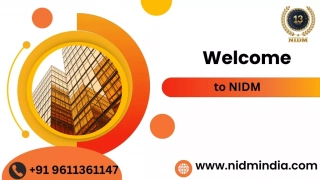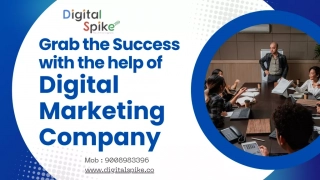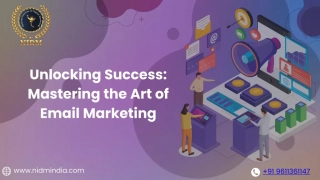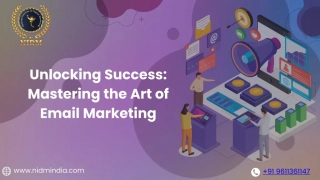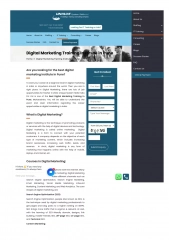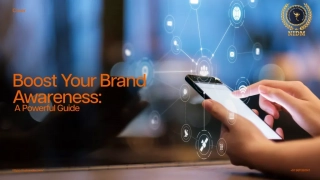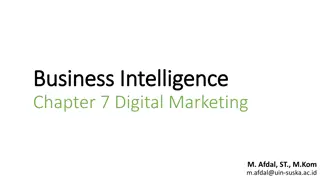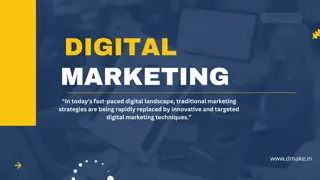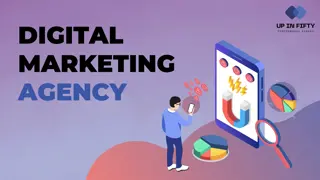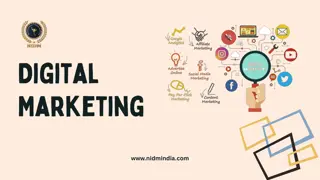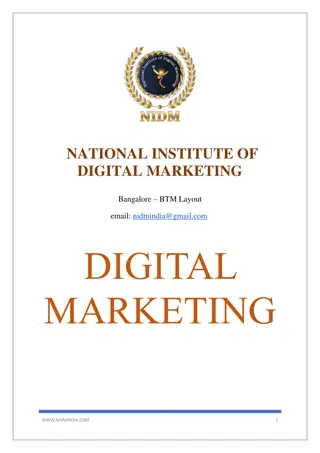
Understanding Internet and Digital Marketing Strategies
Explore the fundamentals of digital marketing, including ICT, internet marketing, digital consumer behavior, and strategy development. Learn how to apply digital technologies to achieve marketing objectives and enhance online company presence through various communication tools.
Download Presentation

Please find below an Image/Link to download the presentation.
The content on the website is provided AS IS for your information and personal use only. It may not be sold, licensed, or shared on other websites without obtaining consent from the author. Download presentation by click this link. If you encounter any issues during the download, it is possible that the publisher has removed the file from their server.
E N D
Presentation Transcript
Digital Marketing Digital marketing fundamentals: 1. ICT ; Internet; Marketing 2. What is Internet/ Digital marketing? 3. the digital marketing environment 4. the digital consumer behaviour Digital marketing information systems Digital marketing strategy development 1. Digital marketing strategy 2. digital marketing mix 3. E-Relationship marketing Digital marketing: implementation and practice Digital marketing: Evaluation and Improvement
What is Internet marketing? Internet marketing The application of the Internet and related digital technologies (in conjunction with traditional communications) marketing objectives. to achieve Achieving marketing objectives through applying digital technologies
What is Digital marketing? Digital marketing The application of the Internet and related digital technologies (in conjunction with traditional communications) marketing objectives. to achieve Achieving marketing objectives through applying digital technologies
What is Internet/ Digital marketing? In practice, Internet/Digital marketing includes managing different forms of online company presence . OCP takes place through: e- communication tools or media channels
Search Engine Optimization (SEO) - optimizing your website and content for search engines to increase visibility and attract organic traffic Paid search: also known as pay-per-click (PPC) advertising, is a form of online advertising in which advertisers pay a fee each time a user clicks on one of their ads. These ads appear on search engine results pages (SERPs) or on other websites through display advertising. Paid for inclusion feeds : are a type of online advertising service that allows website owners to pay a fee in exchange for having their website's content included in a syndicated feed. These feeds are typically used by content aggregators, such as search engines or news websites, to display fresh and relevant content to their users.
Publisher outreach is the process of reaching out to publishers to promote or distribute your content, product, or service. This is a key component of marketing and is essential for anyone who wants to get their message out to a wider audience. Community participation refers to the active involvement of individuals, groups, and organizations in online platforms and digital communities to collaborate, share ideas, and solve problems related to their community. It takes many forms, such as online forums, social media groups, virtual meetings, and crowdfunding platforms. Media alerting is the process of notifying media outlets, journalists, and other members of the press about an upcoming event, announcement, or story. The goal of media alerting is to generate interest in the event or story and to encourage media coverage
Brand protection, refers to the practices and strategies implemented by businesses to safeguard their online brand assets, including their intellectual property rights, online reputation, and customer trust. By: 1. Trademark registration: Registering their trademark with the relevant authorities to prevent others from using it without permission. 2. Monitoring online activity: Constantly monitoring their brand presence online, including social media, websites, and marketplaces, to identify and address any unauthorized use of their brand assets.
Affiliate marketing is when a business rewards affiliates (publishers or marketers) for each customer or sale they bring to the business. In this model, the affiliate promotes the business's products or services to potential customers through various marketing channels such as blogs, social media, email marketing, or paid advertising. E-sponsorship refers to the process of securing sponsorship or funding through online or electronic means. This can include using social media platforms, crowdfunding websites, or other online resources to connect with potential sponsors or donors.
E-Co-branding is a type of co-branding that takes place in the digital realm. It involves two or more online brands collaborating on a product or service that is offered through the internet. E-Co- branding can take many forms, such as a joint website or online store, a joint social media campaign, or a partnership to offer a digital product or service. This can help increase the online visibility of the participating brands, as they are able to leverage each other's online presence and customer base. It can also lead to increased customer trust and loyalty, as customers are more likely to trust a product or service that is endorsed by multiple reputable brands. E-co-branding can also help reduce marketing costs and increase profitability
Link building is the process of acquiring hyperlinks from other websites to your own website. It is an important aspect of search engine optimization (SEO) as search engines use links to determine the authority and relevance of a website. The more high-quality links a website has pointing to it, the more likely it is to rank higher in search engine results pages (SERPs). There are various strategies for building links, including: Content marketing: Creating high-quality, informative content that people want to link to is one of the most effective link building strategies. This infographics, videos, and other types of content. can include blog posts,
Guest blogging: Writing guest posts for other websites in your industry can help you get exposure and build links back to your own site. This strategy requires reaching out to relevant websites and offering to write a guest post in exchange for a link back to your site. Broken link building: This involves finding broken links on other websites and offering to replace them with a link to your own content. This strategy requires a bit of research and outreach, but it can be an effective way to get high-quality links. Link reclamation: This involves finding mentions of your brand or website on other websites that don't include a link, and then reaching out to request that they add one. This strategy can be particularly effective for large brands that have been mentioned frequently but may not have links back to their website. Creating link-worthy resources: Creating resources such as tools, calculators, or other interactive content can be an effective way to attract links naturally.
Site-specific media buys refer to the practice of purchasing advertising space or time on a particular website or online platform. Rather than buying advertising space across a broad range of websites or platforms, site-specific media buys allow advertisers to target specific websites or platforms that align with their target audience or campaign goals. Here ads are seen by the intended audience ,which can lead to higher engagement rates and a better return on investment (ROI) for the advertiser. Ad networks are companies that connect advertisers with publishers who have available advertising space on their websites, mobile apps, or other digital platforms. Ad networks act as intermediaries between advertisers and publishers, providing a platform for advertisers to bid on ad space and for publishers to monetize their online content.
A contra-deal, also known as a barter deal, is a type of transaction where two parties agree to exchange goods or services of equal value without exchanging any money. Instead, the parties agree to provide goods or services to each other, often in exchange for something that they need but cannot afford to pay for outright. For example, a web designer might offer to design a website for a small business in exchange for accounting services, or a clothing company might offer free clothes to a popular fashion blogger in exchange for the blogger featuring the clothing in their blog or Instagram posts.
Behavioral targeting is a marketing technique that involves using data on an individual's online behavior to deliver targeted advertising to them. This is done by collecting information about a user's browsing habits, such as the websites they visit, the pages they view, the links they click, and the searches they perform. This information is then used to create a profile of the user's interests, preferences, and behaviors.
Opt-in email refers to a marketing strategy where individuals voluntarily provide their email address and agree to receive promotional or informational messages from a particular organization. This is usually done through a sign-up form on a website, where the individual enters their email address and gives explicit permission for the company to send them emails. company or
Social Media Marketing - using social media platforms such as Facebook, LinkedIn, and Twitter to engage with potential customers and promote your business. A viral campaign is a marketing strategy that seeks to promote a product, service, or brand by creating a message that spreads quickly and extensively through social media and other online channels. The goal of a viral campaign is to generate buzz and excitement around a product or service, with the ultimate aim of increasing sales or brand awareness.
Audience participation refers to the involvement of individuals or groups in a live event, such as a presentation, workshop, or performance. It can be as simple as asking for a show of hands or as complex as interactive activities that require active engagement from the audience. Audience participation can serve several purposes, such as: Enhancing engagement: Improving learning: Building community: Generating ideas and feedback
Managing social presence involves creating and maintaining a consistent and effective online presence across various social media platforms. Social media has become a critical component of modern-day marketing strategies, as it offers businesses an opportunity to engage with customers, build brand awareness, and drive sales. Here are some tips for managing social presence: 1. Determine your target audience: 2. Choose the right platforms: 3. Develop a content strategy: 4. Engage with your audience 5. Monitor your online reputation: Keep an eye on what people are saying about your brand online and respond to negative comments or reviews promptly. 6. Analyze your results: Regularly track your social media metrics to measure the effectiveness of your social media strategy and adjust your approach accordingly.
What is Internet/ Digital marketing? To help develop a strategy to reach and influence potential customers online, three main types of media channels marketers need to consider today: Paid media, Owned media, Earned media
What is Internet/ Digital marketing? The growing range of digital marketing platforms Desktop, laptop and notebook platforms Mobile phone and tablet platforms Other hardware platforms Software platforms
What is Internet/ Digital marketing? Desktop, laptop and notebook platforms 1. Desktop browser-based platform: Internet Explorer 2. Desktop apps: Apple App Store . 3. Email platforms: yahoo 4. Feed-based and platforms 5. Video-marketing platforms: IPTV . API data exchange
What is Internet/ Digital marketing? 4- Feed-based and API data exchange platforms are two different methods of exchanging data between different systems or platforms. Feed-based data exchange involves providing a file containing data in a specific format, which can be uploaded or imported into another system. The data may be delivered in various file formats. The receiving system may process the data and use it in different ways, such as displaying it to end-users or using it for analysis and reporting. API (Application Programming Interface) data exchange involves using a set of pre-defined rules and protocols to exchange data between different systems. An API provides a set of functions or endpoints that can be accessed by other systems, enabling them to retrieve or update data in a standardized way. APIs can be either public or private, and they can be used to integrate different systems, automate processes, or build new applications.
What is Internet/ Digital marketing? 4- Feed-based and API data exchange platforms Feed-based data exchange is commonly used for data feeds, such as product catalogs, financial data, or news feeds, while API data exchange is more commonly used for real-time interactions, such as online transactions, social media interactions, or real-time data streams. Both feed-based and API data exchange platforms have their advantages and disadvantages, depending on the use case and requirements. Feed-based data exchange is usually simpler and easier to implement, but it may be less flexible and may require manual intervention. API data exchange is more flexible and scalable, but it may require more technical expertise and effort to set up and maintain.
What is Internet/ Digital marketing? Mobile phone and tablet platforms 1. Mobile browsers which are closely integrated with the operating system. 2. Mobile-based apps: Apple iOS, Google Android, RIM or Windows operating system and browser: mobile
What is Internet/ Digital marketing? Other hardware platforms 1. Indoor and outdoor kiosk-type apps: interactive kiosks 2. Gaming platforms: PlayStation, Nintendo or Xbox 3. Interactive signage: Touchscreen, Bluetooth or QR codes 4. Wearables. Smart watches, smart glasses
What is Internet/ Digital marketing? Software platforms Software as a Service (SaaS): Business applications and software services are provided through Internet and web protocols with the application managed on a separate server from where it is accessed through a web browser on an end user s computer with data stored within The Cloud .
What is Internet/ Digital marketing? Different forms of online presence 1.P.24 1 Transactional e-commerce site Enables purchase of products online 2 Services-orientated relationship-building website Provides information to stimulate purchase and build relationships 3 Brand-building site Provides an on line experience to support the brand 4 Portal or media site (www.yahoo.com) 5 Social network or community site: Facebook,
What is Internet/ Digital marketing? Benefits of digital marketing Marketing is the management process responsible for identifying, anticipating and satisfying customer requirements profitably. Digital marketing can be used to support these aims:
What is Internet/ Digital marketing? Benefits of digital marketing Identifying the Internet can be used for marketing research to find out customers needs and wants Anticipating the Internet provides an additional channel by which customers can access information and make purchases Satisfying a key success factor in e-marketing is achieving customer satisfaction electronic channe through the
What is Internet/ Digital marketing? Benefits of digital marketing Internet can be used to achieve four strategic directions: 1 Market penetration. The Internet can be used to sell more existing products into existing markets. 2 Market development. Here the Internet is used to sell into new geographical markets, taking advantage of the low cost of advertising internationally without the necessity for a supporting sales infrastructure in the customers countries. 3 Product development. New products or services are developed which can be delivered by the Internet. These are typically digital products. 4 Diversification. In this sector, the Internet supports selling new products which are developed and sold into new markets.
What is Internet/ Digital marketing? Benefits of digital marketing three main forms of demand expansion for an existing company when it adopts direct Internet channels: Market expansion, occurs when new segments of customers are reached who did not previously buy in a category Brand switching, by winning competitors. Relationship deepening, which is selling more to existing customers customers from
What is Internet/ Digital marketing? What is the difference between e-commerce and e-business? Electronic informational electronically mediated exchanges between an organisation stakeholders commerce: All financial and and its external
What is Internet/ Digital marketing? What is the difference between e-commerce and e-business? Buy-side e-ommerce E-commerce transactions between a purchasing organisation and its suppliers. Sell-side e-commerce E-commerce transactions between a supplier organisation and its customers.
What is Internet/ Digital marketing? What is the difference between e-commerce and e-business? Social commerce: is a subset of e-commerce which encourages participation and interaction of customers in rating, selecting and buying products through group buying. This participation can occur on an e-commerce site or on third-party sites.
What is Internet/ Digital marketing? What is the difference between e-commerce and e-business? E-business or digital business is similar to e- commerce but broader in scope and refers to using digital technology to manage a range of business processes incorporating the sell-side and buy-side e-commerce and also business processes including development, marketing, inbound and outbound logistics. other key research manufacturing supporting and and

